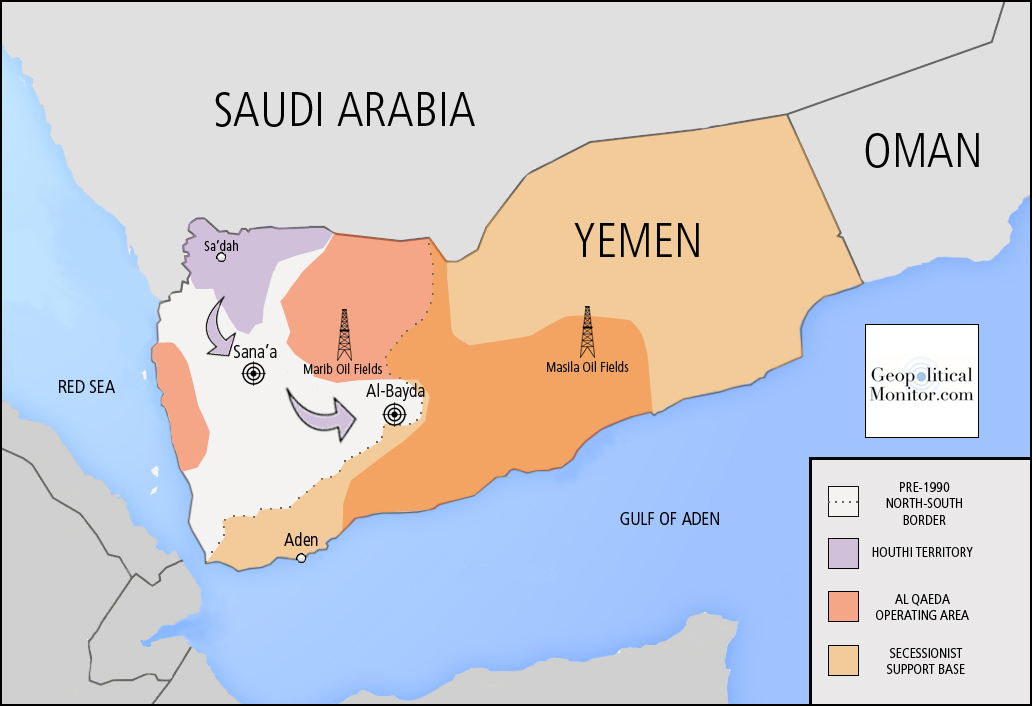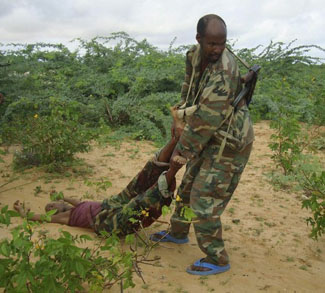Summary
While the central government struggles to cope with bubbling discontent in both north and south Yemen, Al Qaeda stands poised to expand into any vacuum that may form.
Analysis
Yemeni President Ali Abdullah Saleh is presiding over a deteriorating situation domestic situation. In the north, he is struggling to contain a conflict with the Houthis– a group of rebels belonging to the Zaydi sect of Shiite Islam. According to the Yemeni government, the rebels are fighting for the re-establishment of clerical rule in Yemen. The Houthis, on the other hand, claim that they are merely struggling against marginalization and government discrimination.
The conflict in the north has been intensifying as of late. Military strikes by Saudi and Yemeni forces have drawn more and more civilians into the conflict, producing warnings from various UN agencies. According to the UNHCR, over 100,000 Yemeni refugees have fled since the violence started in 2004, and more recently at least one UN refugee camp has been overwhelmed by surging numbers of displaced people. Just last Sunday, the Saudi Air Force bombed Bani Maan in northern Yemen, killing anywhere from thirty-five to seventy civilians.
Saudi Arabia has long kept a close eye on its neighbor, as its core interests stand to suffer if Yemen falls to civil war and anarchy. A cross-border raid into Saudi Arabia by Houthi rebels last November provided Riyadh with the pretense it needed to get directly involved in the conflict.
The situation in the south of Yemen, while markedly less violent, still poses a major threat to the Saleh government in Sana’a. Since losing the civil war against the north in 1994, southern elites have remained marginalized from the Yemeni political process. They have been blocked from civil service positions, passed over for advancement in the security forces, and retired officials are frequently held hostage by a pension payment schedule controlled by the central government.
Discrimination suffered at the hands of the central government as well as the pervasive belief that Yemen’s oil wealth is not being distributed fairly have snowballed into a series of pro-secession protests- the ‘Southern Movement.’
Given the fact that the south is home to around 80 percent of the country’s oil wealth, a divided Yemen would surely bring economic malaise to the north. With this in mind, the northern-dominated Yemeni government has adopted a predictably hard line against the Southern Movement. According to a Human Rights Watch report, government forces have been actively cracking down on secessionist elements in the south. The crackdown has produced a litany of human rights violations: unlawful killings, firing on peaceful protests, government pressure on hospitals to deny care to protestors, and arbitrary arrests.
So far there have been two armed conflicts between groups tied to the Southern Movement and Yemeni security forces. These skirmishes have allowed the Saleh government to claim that the Southern Movement is harboring an armed element that is linked to Al Qaeda. Such claims can be expected, given that any linkage between Al Qaeda and enemies of the state is, and will continue to be, advantageous to President Saleh.
There can be no doubt that there is a significant Al Qaeda presence within Yemen. The country is home to thousands of veterans of the Soviet mujahedeen and is also the ancestral homeland of Osama Bin Laden. It is, however, very unlikely that Al Qaeda has aligned itself with northern or southern anti-government elements, even though they all share an enemy in President Saleh’s government.
Rather than approach Al Qaeda, the Shiite Houthis in the north would prefer to look to Iran for help. Likewise, the Southern Movement will continue to focus on peaceful protest, fully cognizant of the international pariah status that accompanies cooperating with Al Qaeda.
Thus, the Yemeni government must struggle to contain a low-level civil war in the north and avert a large-scale civil war in the south- all in the midst of periodic Al Qaeda attacks on government institutions. It’s no wonder that some Pentagon officials have penciled Yemen in as the world’s next major Al Qaeda sanctuary.
Any new Al Qaeda sanctuary is a threat in the form of potential recruitment and planning opportunities, but one so close to Saudi Arabia and Somalia is even more menacing. Instability in Yemen can easily spill into Saudi Arabia, jeopardizing energy shipments from one of the world’s major oil exporters.
A militant nexus in Yemen would be ideologically and geographically close to Al Shabaab in Somalia. Questions on the threat of radical Islam making dramatic inroads throughout the region aside, a state of anarchy on both sides of the Gulf of Aden would at the very least intensify the threat that piracy poses to international shipping.
It should also be noted that the future may see Iran having a role to play in all this. The Houthis in Yemen represent a useful piece on Iran’s geopolitical chessboard. At any time, Tehran can take up the Houthis’ cause as a means to destabilize Saudi Arabia; Iran’s long-term rival in its’ wider struggle for regional hegemony.




